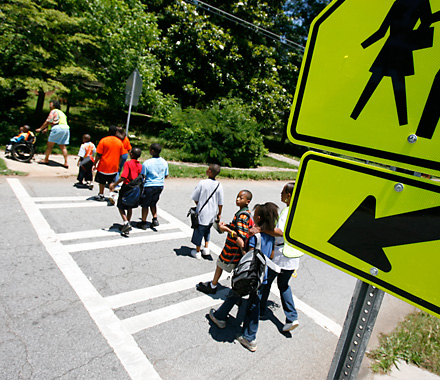Editor's note: The following article contains a brief description of police violence against Black children.
In another sign of declining public confidence in police forces, the Safe Routes Partnership announced yesterday that it is dropping "enforcement" from its official recommendations to program participants.
The nonprofit provides guidance and resources to federally funded Safe Routes to School programs that affects thousands of students in in all 50 states.
Black activists and leaders in the built environment industries have long urged the Partnership to consider the unique dangers that the police have posed to Black children and their wider communities, and remove policing from its recommended framework for creating Safe Routes program. The organization acknowledges that they have been slow to respond to the feedback — until now.
"While we have shifted our communications and guidance away from promoting police as a critical part of traffic-safety initiatives, helped highlight the inequitable impacts of law enforcement on people of color, and promoted traffic and public-safety strategies that do not involve police, we now know that that is not enough," it said in a statement.
Much like the Vision Zero street-safety framework, the Safe Routes Partnership historically has recommended a "five E" approach to keeping students safe on their way to school, including education, encouragement, evaluation, engineering, and until yesterday, enforcement of traffic laws. But many Black and brown parents and school leaders whose communities participate in the program have long maintained that police enforcement itself poses dangers to their children — rather than making them safer on their school commutes.
"When someone’s looking at building, maintaining and growing a Safe Routes program, what a lot of people immediately equate with 'street safety' are simply the laws that govern our intersections, and the enforcement of those laws — usually by police," said Cass Isidro, executive director for the Safe Routes Partnership. "But about five to seven years ago, we started hearing more and more groups saying that they just don’t associate the police with safety — and this was primarily coming from Black and brown communities. We heard them, and we start de-emphasizing enforcement, but it wasn't enough. I hate that we didn't act sooner."
The death of Tamir Rice, 12-year-old Black boy gunned down by a Cleveland police officer in 2014, and Aiyana Jones, a 7-year-old Black girl who was shot and killed while sleeping in her bed by Detroit Police in 2010, are among the most well-known examples of police slayings of Black children. Black adults are almost three times more likely to be killed by police than white adults; BIPOC activists have long argued that Safe Routes' stance on enforcement affects them, too, because many Black parents escort their children to school along these pathways.
In addition to pressure from advocates, Isidro credits the COVID-19 pandemic with speeding the organization's shift to a more antiracist framework. As the outbreak forced millions of children out of traditional school buildings, students often no longer had a traditional commute to school, which required the nonprofit to take a more holistic view of student safety. She also said that ongoing protests that erupted in the wake of the murder of George Floyd helped inspire the statement.
So far, not all responses have been positive.
"We’re already getting the concerned emails," Isidro says. "Some folks are alarmed about dropping enforcement, I think, because they can’t always imagine what that will look like."
The Partnership will undertake a "very strategic and planned" campaign to educate program participants about non-enforcement-based safety strategies, including the replacement of police officers with community crosswalk monitors, as well as stepping up funding for community-led engineering changes, Isidro says.
"Engagement" will now be "the first E [in the Safe Routes framework], as listening to community members and working with existing community organizations is how Safe Routes to School initiatives should begin," the organization's statement said.





